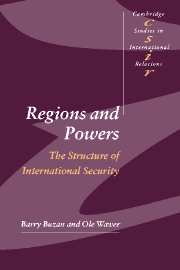Book contents
- Frontmatter
- Contents
- List of illustrations
- Preface
- List of abbreviations
- 1 Patterns of regional security during the Cold War
- 2 Patterns of regional security post-Cold War
- Part I Introduction: developing a regional approach to global security
- Part II Asia
- Part III The Middle East and Africa
- Part IV The Americas
- Introduction
- 9 North America: the sole superpower and its surroundings
- 10 South America: an under-conflictual anomaly?
- Conclusions: scenario for the RSCs of the Americas
- Part V The Europes
- Part VI Conclusions
- Glossary
- References
- News media
- Index of names
- General Index
- CAMBRIDGE STUDIES IN INTERNATIONAL RELATIONS
Conclusions: scenario for the RSCs of the Americas
Published online by Cambridge University Press: 05 December 2009
- Frontmatter
- Contents
- List of illustrations
- Preface
- List of abbreviations
- 1 Patterns of regional security during the Cold War
- 2 Patterns of regional security post-Cold War
- Part I Introduction: developing a regional approach to global security
- Part II Asia
- Part III The Middle East and Africa
- Part IV The Americas
- Introduction
- 9 North America: the sole superpower and its surroundings
- 10 South America: an under-conflictual anomaly?
- Conclusions: scenario for the RSCs of the Americas
- Part V The Europes
- Part VI Conclusions
- Glossary
- References
- News media
- Index of names
- General Index
- CAMBRIDGE STUDIES IN INTERNATIONAL RELATIONS
Summary
Unlike in Asia, there is no American supercomplex that can form the basis of a joint scenario discussion for all of part IV. The main scenarios are regional and in some cases sub-regional, and the separate chapter conclusions therefore stand.
South America is increasingly developing as two subcomplexes with contradictory trends. The Southern Cone is on what is locally taken to be a quite robust, irreversible route to integration. With Argentine– Brazilian rapprochement firmly in place and all border questions solved, the subregion is beyond being a security regime, approaching a security community. It is in the grey zone between the two kinds of RSC, normal and centred. In the northern (Andean) part of the continent, on the other hand, security is increasingly structured by the drugs issue, US involvement, and domestic instability that keeps the border conflicts alive in that part.
North America is and remains one RSC. It became centred early (by the 1860s) and centredness supported a great power (and later superpower) role for the United States. The region has been a security community and largely desecuritised internally under this centred/global regime. With the end of the Cold War, the region is (with some parallels to EU-Europe) resecuritising but along non-state lines, i.e., in post-sovereign format. Due to the historical anti-statism in the USA, such a development can have more far-reaching effects than it would elsewhere in the developed world.
- Type
- Chapter
- Information
- Regions and PowersThe Structure of International Security, pp. 340Publisher: Cambridge University PressPrint publication year: 2003

